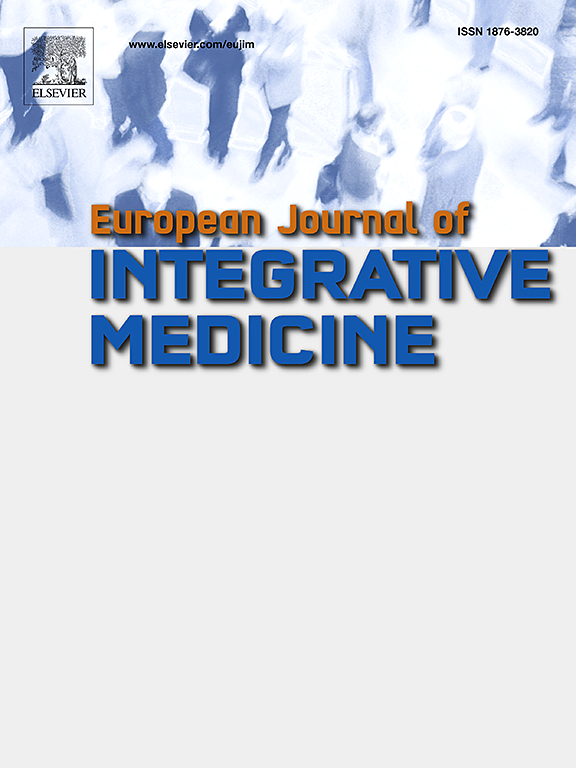Cross-cultural adaptation of the pediatric version of the SafetyNet reporting system for use in French-speaking Canada
IF 1.7
4区 医学
Q3 INTEGRATIVE & COMPLEMENTARY MEDICINE
引用次数: 0
Abstract
Introduction
Though manual therapies are frequently utilized in pediatric care, they carry inherent risks of adverse events. The pediatric iteration of the SafetyNet reporting system encompasses three questionnaires specifically crafted for completion by a child's legal guardian, complemented by one intended for the provider to record treatment details. The objective of this study is to culturally adapt the pediatric SafetyNet reporting system for the French-speaking Canadian demographic.
Methods
A multidisciplinary committee was convened to undertake the translation and cross-cultural adaptation of the four questionnaires comprising the pediatric version of the SafetyNet reporting system. The adaptation process encompassed several stages, including: (1) Forward translation, (2) Synthesis of the translated versions, (3) Cross-cultural adaptation, (4) Review and proposal of the pre-final Canadian French version, and (5) Cognitive debriefing and proposal of the final version. Committee adaptations were subject to review by a developer of the SafetyNet system. Cognitive debriefing involved the participation of French-Canadian legal guardians and clinicians to assess questionnaires’ clarity.
Results
The committee comprised seven researchers and clinicians from diverse backgrounds, including chiropractic, anatomy, and physiotherapy as well as a research associate with a background in linguistics. Upon receiving approval of the cross-cultural adaptations from the developer of the SafetyNet reporting system, all committee members unanimously endorsed the pre-final version. After incorporating improvements based on the cognitive debriefing step, which involved feedback from 13 legal guardians and 10 clinicians, the final version was proposed.
Conclusion
Despite the need for adaptations to existing translation guidelines, the pediatric version of the SafetyNET reporting system was successfully translated and adapted to the Canadian French context.
加拿大法语区儿童版安全报告系统的跨文化改编
虽然手工疗法经常用于儿科护理,但它们具有固有的不良事件风险。SafetyNet报告系统的儿童版本包括三份专门为儿童的法定监护人制作的问卷,以及一份供提供者记录治疗细节的问卷。本研究的目的是对加拿大法语人口统计的儿科安全网报告系统进行文化调整。方法召集一个多学科委员会,对儿童版安全网报告系统的四份问卷进行翻译和跨文化改编。适应过程包括几个阶段,包括:(1)向前翻译,(2)翻译版本的综合,(3)跨文化适应,(4)审查和建议预定稿加拿大法语版本,(5)认知述职和建议定稿版本。委员会的调整须经“安全网”系统的开发人员审查。认知汇报涉及法裔加拿大法律监护人和临床医生的参与,以评估问卷的清晰度。结果该委员会由来自不同背景的七名研究人员和临床医生组成,包括脊椎指压疗法、解剖学和物理疗法,以及一名具有语言学背景的研究助理。在收到SafetyNet报告系统开发者对跨文化改编的批准后,所有委员会成员一致认可了预定稿。在纳入基于认知汇报步骤的改进后,提出了最终版本,该步骤涉及13名法定监护人和10名临床医生的反馈。结论:尽管需要对现有的翻译指南进行调整,儿童版本的SafetyNET报告系统还是成功地翻译并适应了加拿大法语的语境。
本文章由计算机程序翻译,如有差异,请以英文原文为准。
求助全文
约1分钟内获得全文
求助全文
来源期刊

European Journal of Integrative Medicine
INTEGRATIVE & COMPLEMENTARY MEDICINE-
CiteScore
4.70
自引率
4.00%
发文量
102
审稿时长
33 days
期刊介绍:
The European Journal of Integrative Medicine (EuJIM) considers manuscripts from a wide range of complementary and integrative health care disciplines, with a particular focus on whole systems approaches, public health, self management and traditional medical systems. The journal strives to connect conventional medicine and evidence based complementary medicine. We encourage submissions reporting research with relevance for integrative clinical practice and interprofessional education.
EuJIM aims to be of interest to both conventional and integrative audiences, including healthcare practitioners, researchers, health care organisations, educationalists, and all those who seek objective and critical information on integrative medicine. To achieve this aim EuJIM provides an innovative international and interdisciplinary platform linking researchers and clinicians.
The journal focuses primarily on original research articles including systematic reviews, randomized controlled trials, other clinical studies, qualitative, observational and epidemiological studies. In addition we welcome short reviews, opinion articles and contributions relating to health services and policy, health economics and psychology.
 求助内容:
求助内容: 应助结果提醒方式:
应助结果提醒方式:


